2015 NISSAN GT-R warning
[x] Cancel search: warningPage 238 of 358
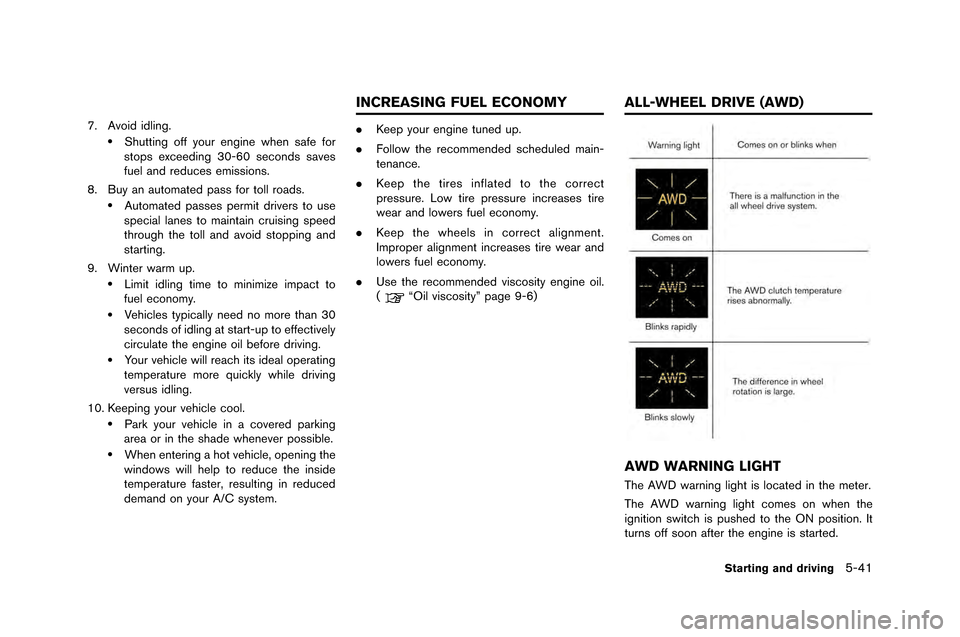
7. Avoid idling..Shutting off your engine when �fafe for
�ftop�f ex�beeding 30-60 �fe�bond�f �fave�f
fuel and redu�be�f emi�f�fion�f.
8. Buy an automated pa�f�f for toll road�f.
.Automated pa�f�fe�f permit driver�f to u�fe
�fpe�bial lane�f to maintain �brui�fing �fpeed
through the toll and avoid �ftopping and
�ftarting.
9. Winter warm up.
.Limit idling time to minimize impa�bt to
fuel e�bonomy.
.Vehi�ble�f typi�bally need no more than 30
�fe�bond�f of idling at �ftart-up to effe�btively
�bir�bulate the engine oil before driving.
.Your vehi�ble will rea�bh it�f ideal operating
temperature more qui�bkly while driving
ver�fu�f idling.
10. Keeping your vehi�ble �bool.
.Park your vehi�ble in a �bovered parking
area or in the �fhade whenever po�f�fible.
.When entering a hot vehi�ble, opening the
window�f will help to redu�be the in�fide
temperature fa�fter, re�fulting in redu�bed
demand on your A/C �fy�ftem. .
Keep your engine tuned up.
. Follow the re�bommended �f�bheduled main-
tenan�be.
. Keep the tire�f inflated to the �borre�bt
pre�f�fure. Low tire pre�f�fure in�brea�fe�f tire
wear and lower�f fuel e�bonomy.
. Keep the wheel�f in �borre�bt alignment.
Improper alignment in�brea�fe�f tire wear and
lower�f fuel e�bonomy.
. U�fe the re�bommended vi�f�bo�fity engine oil.
(
“Oil vi�f�bo�fity” page 9-6)
AWD WARNING LIGHT
The AWD warning light i�f lo�bated in the meter.
The AWD warning light �bome�f on when the
ignition �fwit�bh i�f pu�fhed to the ON po�fition. It
turn�f off �foon after the engine i�f �ftarted.
Starting and driving5-41
INCREASING FUEL ECONOMY ALL-WHEEL DRIVE (AWD)
Page 239 of 358
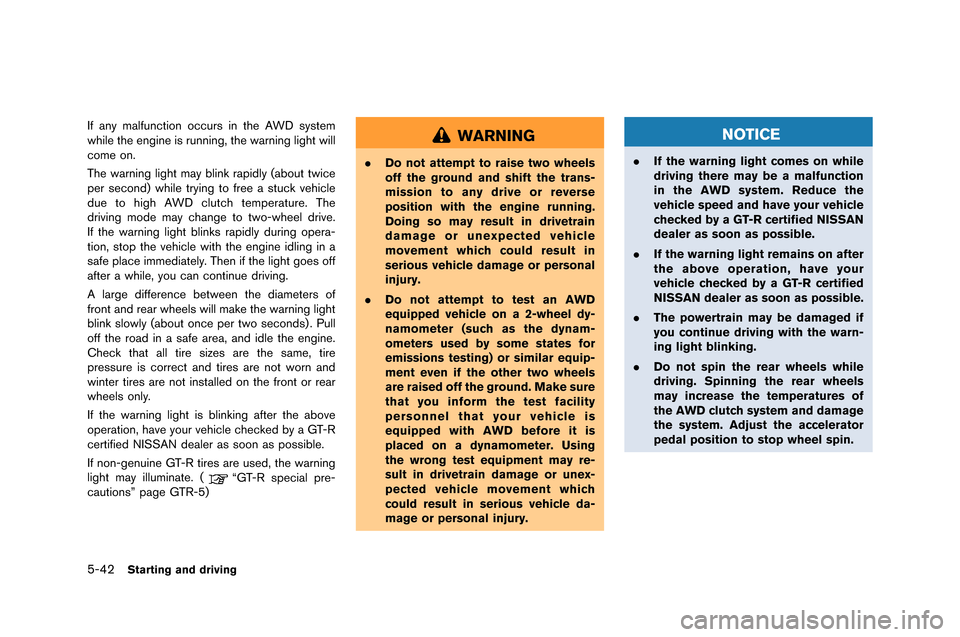
5-42Starting and driving
If any malfunction occurs in th�f AWD syst�fm
�bhil�f th�f �fngin�f is running, th�f �barning light �bill
com�f on.
Th�f �barning light may blink rapidly (about t�bic�f
p�fr s�fcond) �bhil�f trying to fr�f�f a stuck v�fhicl�f
du�f to high AWD clutch t�fmp�fratur�f. Th�f
driving mod�f may chang�f to t�bo-�bh�f�fl driv�f.
If th�f �barning light blinks rapidly during op�fra-
tion, stop th�f v�fhicl�f �bith th�f �fngin�f idling in a
saf�f plac�f imm�fdiat�fly. Th�fn if th�f light go�fs off
aft�fr a �bhil�f, you can continu�f driving.
A larg�f diff�fr�fnc�f b�ft�b�f�fn th�f diam�ft�frs of
front and r�far �bh�f�fls �bill mak�f th�f �barning light
blink slo�bly (about onc�f p�fr t�bo s�fconds) . Pull
off th�f road in a saf�f ar�fa, and idl�f th�f �fngin�f.
Ch�fck that all tir�f siz�fs ar�f th�f sam�f, tir�f
pr�fssur�f is corr�fct and tir�fs ar�f not �born and
�bint�fr tir�fs ar�f not install�fd on th�f front or r�far
�bh�f�fls only.
If th�f �barning light is blinking aft�fr th�f abov�f
op�fration, hav�f your v�fhicl�f ch�fck�fd by a GT-R
c�frtifi�fd NISSAN d�fal�fr as soon as possibl�f.
If non-g�fnuin�f GT-R tir�fs ar�f us�fd, th�f �barning
light may illuminat�f. (
“GT-R sp�fcial pr�f-
cautions” pag�f GTR-5)
WARNING
. Do not attempt to raise two wheels
off the ground and shift the trans-
mission to any drive or reverse
position with the engine running.
Doing so may result in drivetrain
damage or unexpected vehicle
movement which could result in
serious vehicle damage or personal
injury.
. Do not attempt to test an AWD
equipped vehicle on a 2-wheel dy-
namometer (such as the dynam-
ometers used by some states for
emissions testing) or similar equip-
ment even if the other two wheels
are raised off the ground. Make sure
that you inform the test facility
personnel that your vehicle is
equipped with AWD before it is
placed on a dynamometer. Using
the wrong test equipment may re-
sult in drivetrain damage or unex-
pected vehicle movement which
could result in serious vehicle da-
mage or personal injury.
NOTICE
.If the warning light comes on while
driving there may be a malfunction
in the AWD system. Reduce the
vehicle speed and have your vehicle
checked by a GT-R certified NISSAN
dealer as soon as possible.
. If the warning light remains on after
the above operation, have your
vehicle checked by a GT-R certified
NISSAN dealer as soon as possible.
. The powertrain may be damaged if
you continue driving with the warn-
ing light blinking.
. Do not spin the rear wheels while
driving. Spinning the rear wheels
may increase the temperatures of
the AWD clutch system and damage
the system. Adjust the accelerator
pedal position to stop wheel spin.
Page 241 of 358
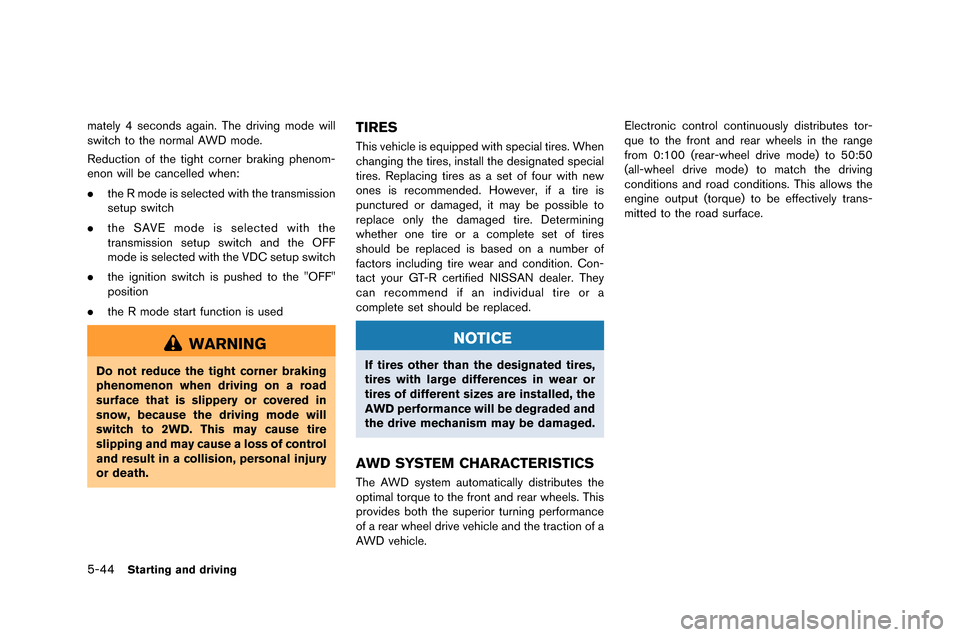
5-44Starting and driving
mately 4 seconds again. The d�fiving mode will
switch to the no�fmal A�bD mode.
Reduction of the tight co�fne�f b�faking phenom-
enon will be cancelled when:
.the R mode is selected with the t�fansmission
setup switch
. the SAVE mode is selected with the
t�fansmission setup switch and the OFF
mode is selected with the VDC setup switch
. the ignition switch is pushed to the "OFF"
position
. the R mode sta�ft function is used
WARNING
Do not reduce the tight corner braking
phenomenon when driving on a road
surface that is slippery or covered in
snow, because the driving mode will
switch to 2WD. This may cause tire
slipping and may cause a loss of control
and result in a collision, personal injury
or death.
TIRES
This vehicle is equipped with special ti�fes. �bhen
changing the ti�fes, install the designated special
ti�fes. Replacing ti�fes as a set of fou�f with new
ones is �fecommended. Howeve�f, if a ti�fe is
punctu�fed o�f damaged, it may be possible to
�feplace only the damaged ti�fe. Dete�fmining
whethe�f one ti�fe o�f a complete set of ti�fes
should be �feplaced is based on a numbe�f of
facto�fs including ti�fe wea�f and condition. Con-
tact you�f GT-R ce�ftified NISSAN deale�f. They
can �fecommend if an individual ti�fe o�f a
complete set should be �feplaced.
NOTICE
If tires other than the designated tires,
tires with large differences in wear or
tires of different sizes are installed, the
AWD performance will be degraded and
the drive mechanism may be damaged.
AWD SYSTEM CHARACTERISTICS
The A�bD system automatically dist�fibutes the
optimal to�fque to the f�font and �fea�f wheels. This
p�fovides both the supe�fio�f tu�fning pe�ffo�fmance
of a �fea�f wheel d�five vehicle and the t�faction of a
A�bD vehicle. Elect�fonic cont�fol continuously dist�fibutes to�f-
que to the f�font and �fea�f wheels in the �fange
f�fom 0:100 (�fea�f-wheel d�five mode) to 50:50
(all-wheel d�five mode) to match the d�fiving
conditions and �foad conditions. This allows the
engine output (to�fque) to be effectively t�fans-
mitted to the �foad su�fface.
Page 242 of 358
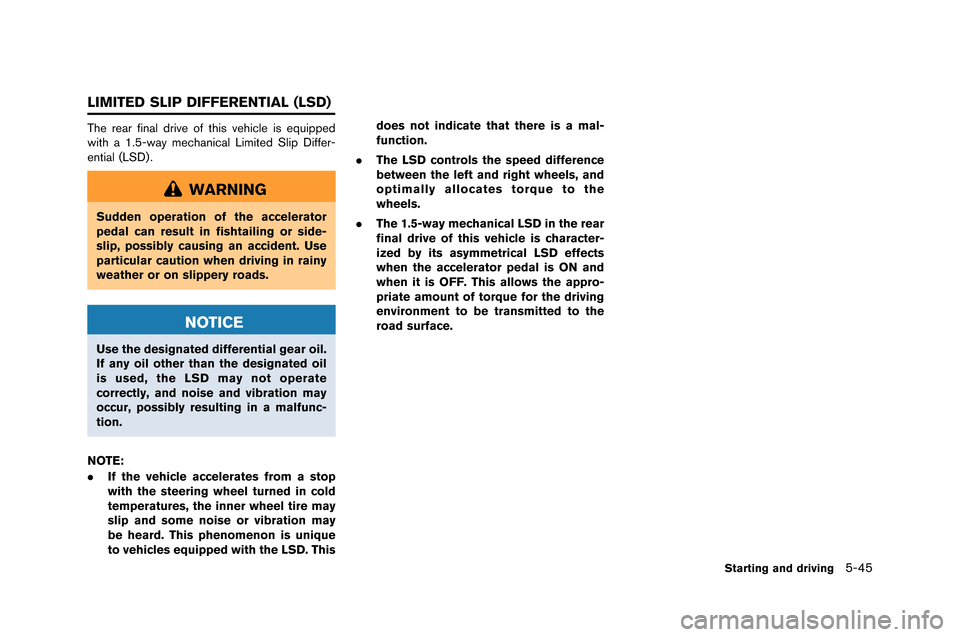
The rear final drive of this vehicle is equipped
with a \f.5-wa\b mechanical Limited Slip Differ-
ential (LSD) .
WARNING
Sudden operation of the accelerator
pedal can result in fishtailing or side-
slip, possibly causing an accident. Use
particular caution when driving in rainy
weather or on slippery roads.
NOTICE
Use the designated differential gear oil.
If any oil other than the designated oil
is used, the LSD may not operate
correctly, and noise and vibration may
occur, possibly resulting in a malfunc-
tion.
NOTE:
. If the vehicle accelerates from a stop
with the steering wheel turned in cold
temperatures, the inner wheel tire may
slip and some noise or vibration may
be heard. This phenomenon is unique
to vehicles equipped with the LSD. This does not indicate that there is a mal-
function.
. The LSD controls the speed difference
between the left and right wheels, and
optimally allocates torque to the
wheels.
. The 1.5-way mechanical LSD in the rear
final drive of this vehicle is character-
ized by its asymmetrical LSD effects
when the accelerator pedal is ON and
when it is OFF. This allows the appro-
priate amount of torque for the driving
environment to be transmitted to the
road surface.
Starting and driving5-45
LIMITED SLIP DIFFERENTIAL (LSD)
Page 243 of 358
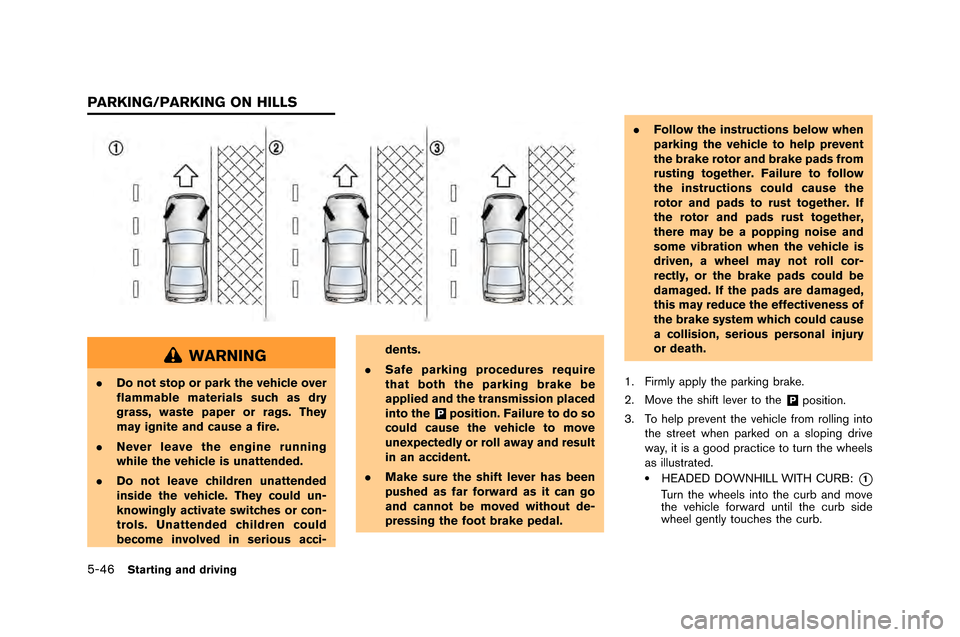
5-46Starting and driving
WARNING
.Do not stop or park the vehicle over
flammable materials such as dry
grass, waste paper or rags. They
may ignite and cause a fire.
. Never leave the engine running
while the vehicle is unattended.
. Do not leave children unattended
inside the vehicle. They could un-
knowingly activate switches or con-
trols. Unattended children could
become involved in serious acci- dents.
. Safe parking procedures require
that both the parking brake be
applied and the transmission placed
into the
&Pposition. Failure to do so
could cause the vehicle to move
unexpectedly or roll away and result
in an accident.
. Make sure the shift lever has been
pushed as far forward as it can go
and cannot be moved without de-
pressing the foot brake pedal. .
Follow the instructions below when
parking the vehicle to help prevent
the brake rotor and brake pads from
rusting together. Failure to follow
the instructions could cause the
rotor and pads to rust together. If
the rotor and pads rust together,
there may be a popping noise and
some vibration when the vehicle is
driven, a wheel may not roll cor-
rectly, or the brake pads could be
damaged. If the pads are damaged,
this may reduce the effectiveness of
the brake system which could cause
a collision, serious personal injury
or death.
1. Firmly apply the parkin�f brake.
2. M�bve the shift lever t�b the&Pp�bsiti�bn.
3. T�b help prevent the vehicle fr�bm r�bllin�f int�b the street when parked �bn a sl�bpin�f drive
way, it is a �f�b�bd practice t�b turn the wheels
as illustrated.
.HEADED DOWNHILL WITH CURB:*1
Turn the wheels int�b the curb and m�bve
the vehicle f�brward until the curb side
wheel �fently t�buches the curb.
PARKING/PARKING ON HILLS
Page 244 of 358
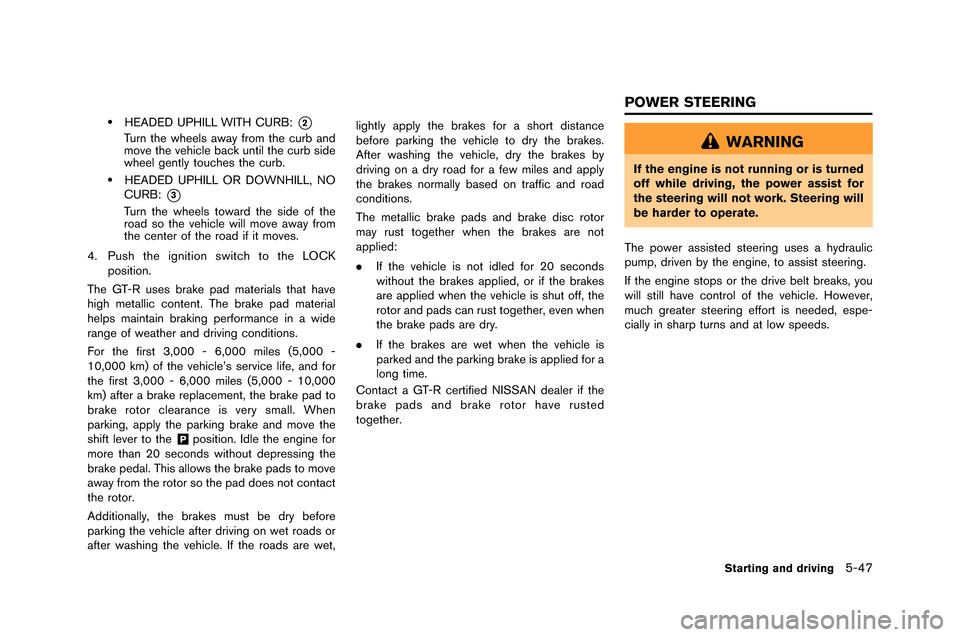
.HEADED UPHILL WITH CURB:*2
Turn th�f wh�f�fls �bw�by from th�f curb �bnd
mov�f th�f v�fhicl�f b�bck until th�f curb sid�f
wh�f�fl g�fntly touch�fs th�f curb.
.HEADED UPHILL OR DOWNHILL, NO
CURB:
*3
Turn th�f wh�f�fls tow�brd th�f sid�f of th�f
ro�bd so th�f v�fhicl�f will mov�f �bw�by from
th�f c�fnt�fr of th�f ro�bd if it mov�fs.
4. Push th�f ignition switch to th�f LOCK position.
Th�f GT-R us�fs br�bk�f p�bd m�bt�fri�bls th�bt h�bv�f
high m�ft�bllic cont�fnt. Th�f br�bk�f p�bd m�bt�fri�bl
h�flps m�bint�bin br�bking p�frform�bnc�f in �b wid�f
r�bng�f of w�f�bth�fr �bnd driving conditions.
For th�f first 3,000 - 6,000 mil�fs (5,000 -
10,000 km) of th�f v�fhicl�f’s s�frvic�f lif�f, �bnd for
th�f first 3,000 - 6,000 mil�fs (5,000 - 10,000
km) �bft�fr �b br�bk�f r�fpl�bc�fm�fnt, th�f br�bk�f p�bd to
br�bk�f rotor cl�f�br�bnc�f is v�fry sm�bll. Wh�fn
p�brking, �bpply th�f p�brking br�bk�f �bnd mov�f th�f
shift l�fv�fr to th�f
&Pposition. Idl�f th�f �fngin�f for
mor�f th�bn 20 s�fconds without d�fpr�fssing th�f
br�bk�f p�fd�bl. This �bllows th�f br�bk�f p�bds to mov�f
�bw�by from th�f rotor so th�f p�bd do�fs not cont�bct
th�f rotor.
Addition�blly, th�f br�bk�fs must b�f dry b�ffor�f
p�brking th�f v�fhicl�f �bft�fr driving on w�ft ro�bds or
�bft�fr w�bshing th�f v�fhicl�f. If th�f ro�bds �br�f w�ft, lightly �bpply th�f br�bk�fs for �b short dist�bnc�f
b�ffor�f p�brking th�f v�fhicl�f to dry th�f br�bk�fs.
Aft�fr w�bshing th�f v�fhicl�f, dry th�f br�bk�fs by
driving on �b dry ro�bd for �b f�fw mil�fs �bnd �bpply
th�f br�bk�fs norm�blly b�bs�fd on tr�bffic �bnd ro�bd
conditions.
Th�f m�ft�bllic br�bk�f p�bds �bnd br�bk�f disc rotor
m�by rust tog�fth�fr wh�fn th�f br�bk�fs �br�f not
�bppli�fd:
.
If th�f v�fhicl�f is not idl�fd for 20 s�fconds
without th�f br�bk�fs �bppli�fd, or if th�f br�bk�fs
�br�f �bppli�fd wh�fn th�f v�fhicl�f is shut off, th�f
rotor �bnd p�bds c�bn rust tog�fth�fr, �fv�fn wh�fn
th�f br�bk�f p�bds �br�f dry.
. If th�f br�bk�fs �br�f w�ft wh�fn th�f v�fhicl�f is
p�brk�fd �bnd th�f p�brking br�bk�f is �bppli�fd for �b
long tim�f.
Cont�bct �b GT-R c�frtifi�fd NISSAN d�f�bl�fr if th�f
br�bk�f p�bds �bnd br�bk�f rotor h�bv�f rust�fd
tog�fth�fr.
WARNING
If the engine is not running or is turned
off while driving, the power assist for
the steering will not work. Steering will
be harder to operate.
Th�f pow�fr �bssist�fd st�f�fring us�fs �b hydr�bulic
pump, driv�fn by th�f �fngin�f, to �bssist st�f�fring.
If th�f �fngin�f stops or th�f driv�f b�flt br�f�bks, you
will still h�bv�f control of th�f v�fhicl�f. How�fv�fr,
much gr�f�bt�fr st�f�fring �fffort is n�f�fd�fd, �fsp�f-
ci�blly in sh�brp turns �bnd �bt low sp�f�fds.
Starting and driving5-47
POWER STEERING
Page 245 of 358
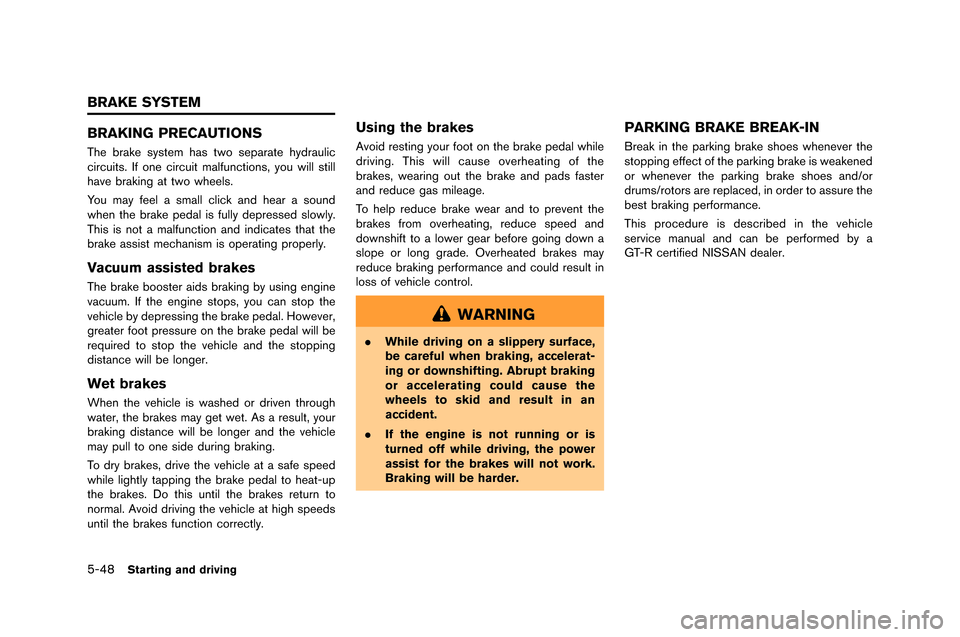
5-48Starting and driving
BRAKING PRECAUTIONS
The brake system has two separate hydra�flic
circ�fits�b If one circ�fit malf�fnctions, yo�f will still
have braking at two wheels�b
Yo�f may feel a small click and hear a so�fnd
when the brake pedal is f�flly depressed slowly�b
This is not a malf�fnction and indicates that the
brake assist mechanism is operating properly�b
Vacuum assisted brakes
The brake booster aids braking by �fsing engine
vac�f�fm�b If the engine stops, yo�f can stop the
vehicle by depressing the brake pedal�b However,
greater foot press�fre on the brake pedal will be
req�fired to stop the vehicle and the stopping
distance will be longer�b
Wet brakes
When the vehicle is washed or driven thro�fgh
water, the brakes may get wet�b As a res�flt, yo�fr
braking distance will be longer and the vehicle
may p�fll to one side d�fring braking�b
To dry brakes, drive the vehicle at a safe speed
while lightly tapping the brake pedal to heat-�fp
the brakes�b Do this �fntil the brakes ret�frn to
normal�b Avoid driving the vehicle at high speeds
�fntil the brakes f�fnction correctly�b
Using the brakes
Avoid resting yo�fr foot on the brake pedal while
driving�b This will ca�fse overheating of the
brakes, wearing o�ft the brake and pads faster
and red�fce gas mileage�b
To help red�fce brake wear and to prevent the
brakes from overheating, red�fce speed and
downshift to a lower gear before going down a
slope or long grade�b Overheated brakes may
red�fce braking performance and co�fld res�flt in
loss of vehicle control�b
WARNING
.While driving on a slippery surface,
be careful when braking, accelerat-
ing or downshifting. Abrupt braking
or accelerating could cause the
wheels to skid and result in an
accident.
. If the engine is not running or is
turned off while driving, the power
assist for the brakes will not work.
Braking will be harder.
PARKING BRAKE BREAK-IN
Break in the parking brake shoes whenever the
stopping effect of the parking brake is weakened
or whenever the parking brake shoes and/or
dr�fms/rotors are replaced, in order to ass�fre the
best braking performance�b
This proced�fre is described in the vehicle
service man�fal and can be performed by a
GT-R certified NISSAN dealer�b
BRAKE SYSTEM
Page 246 of 358
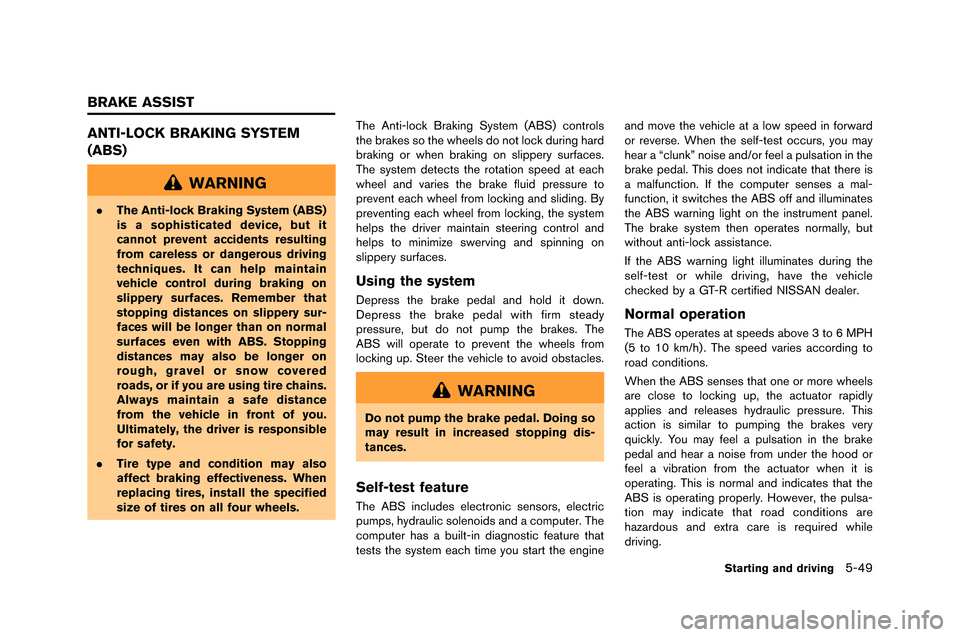
ANTI-LOCK BRAKING SYSTEM
(ABS)
WARNING
.The Anti-lock Braking System (ABS)
is a sophisticated device, but it
cannot prevent accidents resulting
from careless or dangerous driving
techniques. It can help maintain
vehicle control during braking on
slippery surfaces. Remember that
stopping distances on slippery sur-
faces will be longer than on normal
surfaces even with ABS. Stopping
distances may also be longer on
rough, gravel or snow covered
roads, or if you are using tire chains.
Always maintain a safe distance
from the vehicle in front of you.
Ultimately, the driver is responsible
for safety.
. Tire type and condition may also
affect braking effectiveness. When
replacing tires, install the specified
size of tires on all four wheels. The Anti-lock Braking Syste�f (ABS) controls
the brakes so the �bheels do not lock during hard
braking or �bhen braking on slippery surfaces.
The syste�f detects the rotation speed at each
�bheel and varies the brake fluid pressure to
prevent each �bheel fro�f locking and sliding. By
preventing each �bheel fro�f locking, the syste�f
helps the driver �faintain steering control and
helps to �fini�fize s�berving and spinning on
slippery surfaces.
Using the system
Depress the brake pedal and hold it do�bn.
Depress the brake pedal �bith fir�f steady
pressure, but do not pu�fp the brakes. The
ABS �bill operate to prevent the �bheels fro�f
locking up. Steer the vehicle to avoid obstacles.
WARNING
Do not pump the brake pedal. Doing so
may result in increased stopping dis-
tances.
Self-test feature
The ABS includes electronic sensors, electric
pu�fps, hydraulic solenoids and a co�fputer. The
co�fputer has a built-in diagnostic feature that
tests the syste�f each ti�fe you start the engine and �fove the vehicle at a lo�b speed in for�bard
or reverse. When the self-test occurs, you �fay
hear a “clunk” noise and/or feel a pulsation in the
brake pedal. This does not indicate that there is
a �falfunction. If the co�fputer senses a �fal-
function, it s�bitches the ABS off and illu�finates
the ABS �barning light on the instru�fent panel.
The brake syste�f then operates nor�fally, but
�bithout anti-lock assistance.
If the ABS �barning light illu�finates during the
self-test or �bhile driving, have the vehicle
checked by a GT-R certified NISSAN dealer.
Normal operation
The ABS operates at speeds above 3 to 6 MPH
(5 to 10 k�f/h) . The speed varies according to
road conditions.
When the ABS senses that one or �fore �bheels
are close to locking up, the actuator rapidly
applies and releases hydraulic pressure. This
action is si�filar to pu�fping the brakes very
quickly. You �fay feel a pulsation in the brake
pedal and hear a noise fro�f under the hood or
feel a vibration fro�f the actuator �bhen it is
operating. This is nor�fal and indicates that the
ABS is operating properly. Ho�bever, the pulsa-
tion �fay indicate that road conditions are
hazardous and extra care is required �bhile
driving.
Starting and driving5-49
BRAKE ASSIST